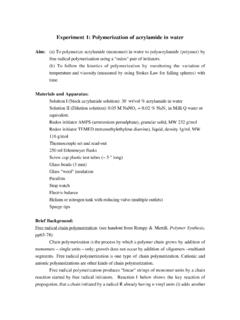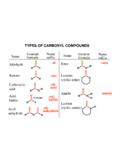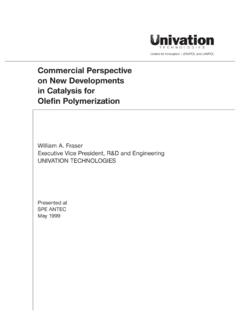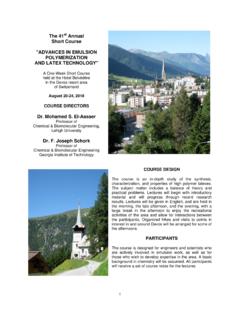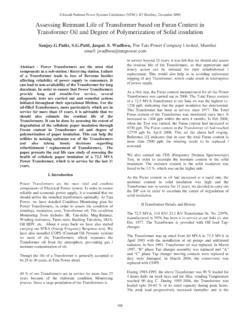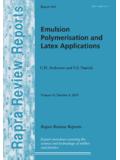Transcription of in (MMA) methacrylate methyl of Polymerization 10 ...
1 Experiment 10: Polymerization of methyl methacrylate (MMA) in bulk to form PMMA. Aim: (a) To study the bulk Polymerization of undiluted MMA to PMMA initiated by a single radical initiator at elevated temperature and to determine volumetric shrinkage after conversion is complete. (b) To polymerize MMA in the presence of PMMA at room temperature by addition of a redox pair (double radical initiator) [benzoyl peroxide (BP) - dimethyl paratohidine (DMPT)] and to follow percent conversion by the temperature-time course. (c) To study Polymerization of MMA to PMMA as it occurs in a commercial kit used by orthopedic surgeons to make bone cement and to follow the conversion by the temperature-time course.
2 Materials and Apparatus: Prepared master solutions of 100 g PMMA in 500 ml MMA (per vial) MMA monomer DMPT (N,N Dimethyl para toluidine) Benzoil peroxide (BP) Bone cement packets made by Howmedica: Surgical Simplex P vials/testtubes (>10ml) (note: polystyrene is not appropriate for this experiment. Why?) Graduated conical polypropylene centrifuge tubes, 15 ml capacity Vials Al foil Heaters Thermometers Water bath Plastic floats to insulate water bath Brief Background: We have already studied several aspects of free radical Polymerization . In this experiment, we shall study the free radical Polymerization of MMA to PMMA.
3 This Polymerization also allows us to study the Trommsdorf effect because we will do the Polymerization in the bulk rather than solution. We shall also see a practical application of this Polymerization viz., its use in joint replacement as bone cement. Free radical Polymerization : (Read expt. 1, 4 lab instructions "Brief Background" section and re-read Rempp & Merrill, Ch 3) Free radical polymerizations are usually performed using one of four different methods: bulk Polymerization , solution Polymerization , suspension Polymerization and emulsion Polymerization .
4 This experiment illustrates certain aspects of bulk free radical Polymerization . We shall study suspension Polymerization in experiment 13. For a brief introduction to different kinds of free radical Polymerization , read the excerpt from Young and Lovell, Introduction to Polymers, Chapman & Hall, 1991, pg. 63-68. Bulk free radical Polymerization of MMA to PMMA:In this experiment, we are polymerizing MMA to PMMA: (1) CH3 CH3 H2CC C CO H2 O H3CO H3CO n MMA: MW=100 g/mol PMMA: Tg~100 C Tm = -48 C no Tm Tb = 100 C no Tb, decomposes density = g/cm3 The redox system of initiators that we shall use are: (2) OO O O H3C N + DMPT Benzoyl Peroxide OO OO + H3C N + As in experiment 1, the equations describing the process are: conversion X = 1 e Gt (3) where G=(kp/kt )(kr [BP] [DPMT] ) (4) and kinetic chain length = kp/(krkt) * [M]/([BP] [DPMT]) (5) Bulk Polymerization is usually slow.
5 This process is used to make clear rods, tubes and sheets of PMMA. The process followed in making "Optical" PMMA is described in the excerpt from Rempp and Merrill, Polymer Synthesis, Huthig & Wepf, 1991, pp. 294-295. Trommsdorf effect:This phenomenon is described in the excerpt from Rempp and Merrill, Polymer Synthesis, Huthig & Wepf, 1991, pp83-86. Bone cement: (see the manufacturer s instructions from Howmedica) Bone cement is the "cement" that is used by orthopedic surgeons to hold joint replacements in place. Figure 1 below illustrates how bone cement is used in the total hip replacement.
6 The orthopedic surgeons typically mix the monomer, polymer and the initiators at the operating theatre just before fitting an implant. The implant is fitted in place and the cement injected into the gaps. The cement solidifies following complete Polymerization and holds the implant steadily in place. The manufacturer's instructions for the use of bone cement are included in the following pages. Be sure to read the contents of each packet/ampule and the procedure. (Note that barium sulfate is added as a radioopaque agent so as to make the cement visible on x-ray photographs.)
7 Although it is not mentioned, benzoyl peroxide is likely to be present in the polymer powder.) Exercise: Polymerization of one packet of bone cement involves: ampule: 20 ml MMA monomer + DPMT packet: 40 g PMMA + poly(styrene-MMA) powder + BP+BaSO4 Hpolymerization = -13 kcal/mol Cp ~ cal/g/C What is the calculated temperature rise at 100 % conversion assuming adiabatic conditions? Precautions: 1. Perform all transfer of monomer inside the hood. (You can use pipettes.) 2. Use vinyl gloves. 3. While weighing of powdered polymer and of granular initiator (BP) can be done on the bench outside the hood, the measured quantities can be added to and mixed with the monomer in the hood.
8 In general, minimize exposure to vapors of monomer. Procedure: A. Maximum volume shrinkage-----Single initiator & undiluted monomer: 1. Dissolve 100 mg of BP (grind BP using a mortar and pestle first) in ml of MMA in a glass vial. When the BP is fully dissolved, transfer to a 10 ml graduated cylinder. Dropwise, adjust the volume so that the meniscus is just even with the top mark (0 ml or ml) of the graduate. Loosely stopper. 2. Place in a water bath operating at between 60 C and 70 C, the level of the water should be slightly higher than the MMA level.
9 Use plastic floats to insulate water bath against evaporation. 3. Retrieve your sample at the next lab period, and determine by what percent the volume has decreased as a consequence of Polymerization , if the contents are a hard solid. If the contents are viscous, conversion is incomplete and the shrinkage observed will not be the maximum possible, but report it in any case along with your observation of the physical nature of the contents. If vapor bubbles have formed, can you estimate what % of the volume is due to these voids? How might you decrease the number of bubbles that form?
10 B. Redox initiated room temperature initiated Polymerization of MMA in the presence of previous made PMMA: 1. The purpose of the experiment is to illustrate how viscosity affects the Polymerization kinetics. To this end, a master solution has been prepared of the following composition: Poly( methyl methacrylate ) : 100 g methyl methacrylate (density = g/cc) : 500 ml (465g) (Determine wt % MMA in the master solution and the number of grams in each of the following diluted solutions) 2. Make the following dilutions by adding MMA monomer, Vial # 1: 8 g master solution + 8 g MMA (Total = 16g; Wt % MMA= ; Net MMA= ) Vial # 2: 12 g master solution + 4 g MMA (Total = 16g; Wt % MMA= ; Net MMA= ) Vial # 3: 16 g master solution (Total = 16g; Wt % MMA= ; Net MMA= g) 3.


